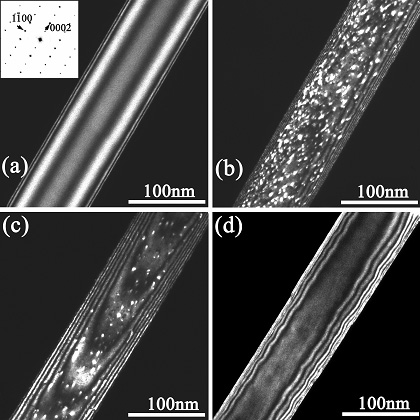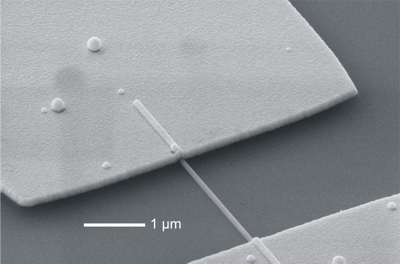ZnO Nanorods

Zinc oxide (ZnO) is a II-VI semiconductor with a large bandgap energy of ~3.4 eV which is considered as a promising material for optoelectronic devices in the near UV spectral region and for sensing devices. In the past years, research activities on ZnO have strongly increased due to the availability of ZnO nanostructures (nanorods, nanocombs, nanobelts) in high quality which can be grown, e.g., by the vapour liquid solid (VLS) technique or by metal organic chemical vapour deposition (MOCVD). ZnO nanorods are investigated most intensely among the different types of nanostructures with respect to its structural and optical properties.Our research focuses on the electrical and structural properties of single ZnO nanorods.
The picture on the right shows dark-field TEM images of ZnO nanorods: (a) unimplanted nanorod, (b) implanted nanorod with a dose of 5×1013 cm-2, (c) implanted nanorod with a dose of 5×1013 cm-2 after 600°C annealing treatment, (d) implanted nanorod with a dose of 5×1013 cm-2 after 700°C annealing treatment.
The image below shows an electrically contacted ZnO-nanowire. 
Selected conference poster presentations:
ZnO-Nanosäulen: Herstellung, Eigenschaften und Bauelemente (pdf)
Strukturelle und elektrische Eigenschaften von Ga-implantierten ZnO-Nanosäulen (pdf)
Selected publications:
[1] E. Müller, P. Kruse, D. Gerthsen, M. Schowalter, A. Rosenauer, D. Lamoen, R. Kling, A. Waag, Measurement of the mean inner potential of ZnO nanorods by transmission electron holography, Appl. Phys. Lett. 86, 154108 (2005)
[2] S. Christiansen, R. Schneider, R. Scholz, U. Gösele, Th. Stelzner, G. Andrä, E. Wendler, W. Wesch, Vapor-liquid-solid growth of silicon nanowires by chemical vapor deposition on implanted templates, J. Appl. Phys. 100, 084323-1-5 (2006)
[3] S. Sadofev, S. Blumstengel, J. Cui, J. Puls, F. Henneberger, R. Schneider, D. Litvinov, D. Gerthsen, Uniform and radiation efficient ZnO/ZnMgO multiple quantum well structures grown by radical source molecular beam epitaxy, Jap. J. Appl. Phys. 45, L1250 (2006)
[4] Daniel Weissenberger, Michael Dürrschnabel, Dagmar Gerthsen, Fabian Perez-Willard, Anton Reiser, Günther Prinz, Martin Feneberg, Klaus Thonke and Rolf Sauer, Conductivity of single ZnO nanorods after Ga-implantation in a Focused-Ion-Beam System, Appl. Phys. Lett. 91, 132110 (2007) (Also selected for publication in the Virtual Journal of Nanoscale Science and Technology)
[5] Huijuan Zhou, Johannes Fallert, Janos Sartor, Roman Dietz, Claus Klingshirn, Heinz Kalt, Daniel Weissenberger, Dagmar Gerthsen, Haibo Zeng and Weiping Cai, Ordered n-type ZnO nanorod arrays, Appl. Phys. Lett. 92, 132112 (2008) (Also selected for publication in the Virtual Journal of Nanoscale Science and Technology
[6] D. Weissenberger, D. Gerthsen, A. Reiser, G.M. Prinz, M. Feneberg, K. Thonke, H. Zhou, J. Sartor, J. Fallert, C. Klingshirn, and H. Kalt, Influence of the measurement procedure on the field-effect dependent conductivity of ZnO nanorods, Appl. Phys. Lett. 94, 042107 (2009) ![]()
[7] L.D. Yao, D. Weissenberger, M. Dürrschnabel, D. Gerthsen, I. Tischer, M. Wiedenmann, M. Feneberg, A. Reiser, and K. Thonke, Structural and cathodoluminescence properties of ZnO nanorods after Ga-implantation and annealing, J. Appl. Phys. 105, 103521 (2009)